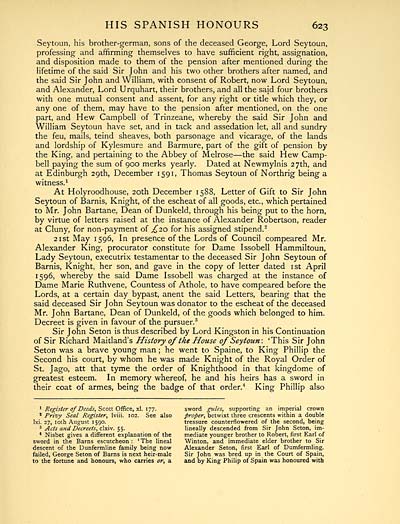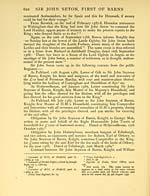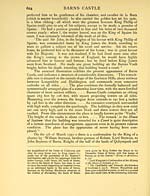Download files
Complete book:
Individual page:
Thumbnail gallery: Grid view | List view

HIS SPANISH HONOURS
623
Seytoun, his brother-german, sons of the deceased George, Lord Seytoun,
professing and affirming themselves to have sufficient right, assignation,
and disposition made to them of the pension after mentioned during the
lifetime of the said Sir John and his two other brothers after named, and
the said Sir John and William, with consent of Robert, now Lord Seytoun,
and Alexander, Lord Urquhart, their brothers, and all the said four brothers
with one mutual consent and assent, for any right or title which they, or
any one of them, may have to the pension after mentioned, on the one
part, and Hew Campbell of Trinzeane, whereby the said Sir John and
William Seytoun have set, and in tack and assedation let, all and sundry
the feu, mails, teind sheaves, both parsonage and vicarage, of the lands
and lordship of Kylesmure and Barmure, part of the gift of pension by
the King, and pertaining to the Abbey of Melrose — the said Hew Camp-
bell paying the sum of 900 merks yearly. Dated at Newmylnis 27th, and
at Edinburgh 29th, December 1591, Thomas Seytoun of Northrig being a
witness. 1
At Holyroodhouse, 20th December 1588, Letter of Gift to Sir John
Seytoun of Barnis, Knight, of the escheat of all goods, etc., which pertained
to Mr. John Bartane, Dean of Dunkeld, through his being put to the horn,
by virtue of letters raised at the instance of Alexander Robertson, reader
at Cluny, for non-payment of ^20 for his assigned stipend. 2
21st May 1596, In presence of the Lords of Council compeared Mr.
Alexander King, procurator constitute for Dame Issobell Hammiltoun,
Lady Seytoun, executrix testamentar to the deceased Sir John Seytoun of
Barnis, Knight, her son, and gave in the copy of letter dated 1st April
1596, whereby the said Dame Issobell was charged at the instance of
Dame Marie Ruthvene, Countess of Athole, to have compeared before the
Lords, at a certain day bypast, anent the said Letters, bearing that the
said deceased Sir John Seytoun was donator to the escheat of the deceased
Mr. John Bartane, Dean of Dunkeld, of the goods which belonged to him.
Decreet is given in favour of the pursuer. 3
Sir John Seton is thus described by Lord Kingston in his Continuation
of Sir Richard Maitland's History of the House of Seytoun: 'This Sir John
Seton was a brave young man ; he went to Spaine, to King Phillip the
Second his court, by whom he was made Knight of the Royal Order of
St. Jago, att that tyme the order of Knighthood in that kingdome of
greatest esteem. In memory whereof, he and his heirs has a sword in
their coat of armes, being the badge of that order. 4 King Phillip also
1 Register of Deeds, Scott Office, xl. 177.
1 Privy Seal Register, lviii. 102. See also
lxi. 27, 10th August 1590.
3 Acts and Decreets, clxiv. 55.
4 Nisbet gives a different explanation of the
sword in the Barns escutcheon : ' The lineal
descent of the Dunfermline family being now
failed, George Seton of Barns is next heir-male
to the fortune and honours, who carries or, a
sword gules, supporting an imperial crown
proper, betwixt three crescents within a double
tressure counterflowered of the second, being
lineally descended from Sir John Seton, im-
mediate younger brother to Robert, first Earl of
Winton, and immediate elder brother to Sir
Alexander Seton, first Earl of Dumfermling.
Sir John was bred up in the Court of Spain,
and by King Philip of Spain was honoured with
623
Seytoun, his brother-german, sons of the deceased George, Lord Seytoun,
professing and affirming themselves to have sufficient right, assignation,
and disposition made to them of the pension after mentioned during the
lifetime of the said Sir John and his two other brothers after named, and
the said Sir John and William, with consent of Robert, now Lord Seytoun,
and Alexander, Lord Urquhart, their brothers, and all the said four brothers
with one mutual consent and assent, for any right or title which they, or
any one of them, may have to the pension after mentioned, on the one
part, and Hew Campbell of Trinzeane, whereby the said Sir John and
William Seytoun have set, and in tack and assedation let, all and sundry
the feu, mails, teind sheaves, both parsonage and vicarage, of the lands
and lordship of Kylesmure and Barmure, part of the gift of pension by
the King, and pertaining to the Abbey of Melrose — the said Hew Camp-
bell paying the sum of 900 merks yearly. Dated at Newmylnis 27th, and
at Edinburgh 29th, December 1591, Thomas Seytoun of Northrig being a
witness. 1
At Holyroodhouse, 20th December 1588, Letter of Gift to Sir John
Seytoun of Barnis, Knight, of the escheat of all goods, etc., which pertained
to Mr. John Bartane, Dean of Dunkeld, through his being put to the horn,
by virtue of letters raised at the instance of Alexander Robertson, reader
at Cluny, for non-payment of ^20 for his assigned stipend. 2
21st May 1596, In presence of the Lords of Council compeared Mr.
Alexander King, procurator constitute for Dame Issobell Hammiltoun,
Lady Seytoun, executrix testamentar to the deceased Sir John Seytoun of
Barnis, Knight, her son, and gave in the copy of letter dated 1st April
1596, whereby the said Dame Issobell was charged at the instance of
Dame Marie Ruthvene, Countess of Athole, to have compeared before the
Lords, at a certain day bypast, anent the said Letters, bearing that the
said deceased Sir John Seytoun was donator to the escheat of the deceased
Mr. John Bartane, Dean of Dunkeld, of the goods which belonged to him.
Decreet is given in favour of the pursuer. 3
Sir John Seton is thus described by Lord Kingston in his Continuation
of Sir Richard Maitland's History of the House of Seytoun: 'This Sir John
Seton was a brave young man ; he went to Spaine, to King Phillip the
Second his court, by whom he was made Knight of the Royal Order of
St. Jago, att that tyme the order of Knighthood in that kingdome of
greatest esteem. In memory whereof, he and his heirs has a sword in
their coat of armes, being the badge of that order. 4 King Phillip also
1 Register of Deeds, Scott Office, xl. 177.
1 Privy Seal Register, lviii. 102. See also
lxi. 27, 10th August 1590.
3 Acts and Decreets, clxiv. 55.
4 Nisbet gives a different explanation of the
sword in the Barns escutcheon : ' The lineal
descent of the Dunfermline family being now
failed, George Seton of Barns is next heir-male
to the fortune and honours, who carries or, a
sword gules, supporting an imperial crown
proper, betwixt three crescents within a double
tressure counterflowered of the second, being
lineally descended from Sir John Seton, im-
mediate younger brother to Robert, first Earl of
Winton, and immediate elder brother to Sir
Alexander Seton, first Earl of Dumfermling.
Sir John was bred up in the Court of Spain,
and by King Philip of Spain was honoured with
Set display mode to:
![]() Universal Viewer |
Universal Viewer | ![]() Mirador |
Large image | Transcription
Mirador |
Large image | Transcription
Images and transcriptions on this page, including medium image downloads, may be used under the Creative Commons Attribution 4.0 International Licence unless otherwise stated. ![]()
| Histories of Scottish families > History of the family of Seton during eight centuries > Volume 2 > (57) |
|---|
| Permanent URL | https://digital.nls.uk/96847506 |
|---|
| Attribution and copyright: |
|
|---|---|
| Description | A selection of almost 400 printed items relating to the history of Scottish families, mostly dating from the 19th and early 20th centuries. Includes memoirs, genealogies and clan histories, with a few produced by emigrant families. The earliest family history goes back to AD 916. |
|---|

